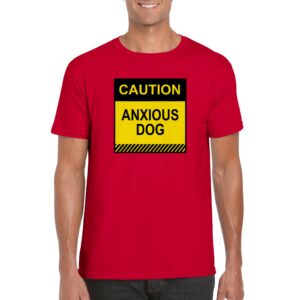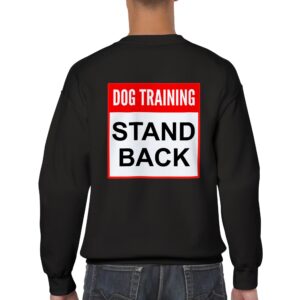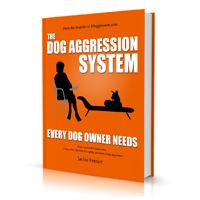Your cart is currently empty!
Which Medication Should be Used for Dog Aggression?

If you’re exploring medication options for dog aggression, this guide will help you understand which treatments might be suitable. Whether your dog is already on medication or you’re considering new options, this article provides insights into:
- Factors a veterinary behaviorist considers when prescribing medication
- About common medications used for dog aggression, including side effects
- Medications commonly prescribed for various types of dog aggression issues
- Supplements and other therapeutic aids
- Important considerations when using medications for dog aggression
Understanding Aggression in Dogs
Aggression in dogs often signals a deeper issue, such as fear, anxiety, or medical conditions. For instance, poor socialization can lead to anxiety-driven aggression. Similarly, frustration might trigger aggressive behavior.
Addressing the Root Causes
Effective treatment involves identifying and addressing these underlying issues. Simply managing the aggression without tackling its cause is unlikely to bring lasting improvement. Understanding aggression as a symptom helps target the real problem for better outcomes.
Combining Medications with Behavior Modification
Medication alone usually isn’t enough to resolve aggression. It can help by reducing anxiety or stabilizing mood, making it easier for dogs to learn new behaviors through structured training. A combination of medication and behavior modification addresses both symptoms and underlying causes, increasing the chances of long-term success.
Factors Considered by Vets When Prescribing Medication
Veterinarians consider various factors when choosing medication for dog aggression:
- Types of problems and symptoms
- Genetic predisposition
- Health issues
- Environmental factors (e.g., presence of young children)
- Specific behavior indications (e.g., hyperactivity, separation anxiety, compulsion)
- Breed characteristics (e.g., reactivity, aggression, problem-solving abilities)
Exploring Additional Options
Medications are not the only option. There are supplements and therapeutic aids that can help. However, depending on the severity of the anxiety or aggression, medication may be necessary.
About Common Medications for Dog Aggression
According to Clinical Behavioural Medicine for Small Animals by Dr. Karen Overall, the following drugs may be prescribed:
Fluoxetine (Prozac® in human form, Reconcile® for dogs)
USED FOR: For owner-directed aggression, fear aggression, inter-dog aggression, separation anxiety, and obsessive-compulsive behaviors.
What Is Fluoxetine?
Fluoxetine is a type of SSRI that works by increasing the levels of serotonin in the brain. Serotonin is a neurotransmitter that helps regulate mood, anxiety, and behavior. By enhancing serotonin levels, Fluoxetine can help manage various behavioral problems in dogs.
How Fluoxetine Works
- Mechanism: Fluoxetine increases serotonin levels by inhibiting its reuptake in the brain, which helps regulate mood and anxiety.
- Onset: It typically takes 4 to 6 weeks to observe noticeable improvements in behavior. During this time, it is important to continue with behavior modification training to maximize the benefits of the medication.
Administration and Dosage
- Dosage: The dosage of Fluoxetine varies depending on the dog’s size, weight, and specific condition. Your veterinarian will provide a precise dosage based on these factors.
- Administration: Fluoxetine is usually administered orally, and it’s important to follow the veterinarian’s instructions carefully to ensure effectiveness.
Side Effects
- Common Side Effects: Some dogs may experience side effects such as lethargy, changes in appetite, or gastrointestinal upset. These effects are often temporary.
- Monitoring: Regular follow-up with your veterinarian is crucial to monitor the dog’s response to the medication and adjust the dosage if necessary.
Additional Considerations
Long-Term Use: Depending on the dog’s condition, Fluoxetine may be used long-term. Regular check-ins with your veterinarian will help ensure that the medication continues to be effective and safe.
Combination with Behavior Modification: Fluoxetine works best when combined with behavior modification techniques. Training can help reinforce positive behaviors and address the root causes of aggression or anxiety.
Learn more about Fluoxetine on Veterinary Partner.
Sertraline (Zoloft®)
USED FOR: For owner-directed aggression and separation anxiety. May also be used for fear aggression, Inter-dog aggression, and obsessive-compulsive behaviors.
What Is Sertraline?
Sertraline is an SSRI that works by increasing serotonin levels in the brain. This neurotransmitter plays a critical role in regulating mood, anxiety, and behavior. By elevating serotonin levels, Sertraline helps manage a range of behavioral problems in dogs.
How Sertraline Works
- Mechanism: Sertraline enhances serotonin levels by blocking its reuptake in the brain, which helps stabilize mood and reduce anxiety.
- Onset: It usually takes 4 to 6 weeks to see significant improvements in behavior. Consistent use is key, and behavior modification techniques should complement the medication.
Administration and Dosage
- Dosage: The dosage of Sertraline depends on the dog’s size, weight, and specific condition. Your veterinarian will determine the appropriate dosage.
- Administration: Sertraline is given orally, and it is crucial to follow your veterinarian’s instructions to ensure proper dosing and effectiveness.
Side Effects
- Common Side Effects: Possible side effects include gastrointestinal upset, changes in appetite, or mild sedation. These effects are often temporary.
- Monitoring: Regular veterinary check-ups are important to monitor the dog’s response and adjust the dosage if needed.
Additional Considerations
- Combination with Behavior Modification: Sertraline is most effective when used in conjunction with behavior modification strategies. Training helps address the underlying causes of aggression or anxiety.
- Long-Term Use: For some dogs, Sertraline may be used long-term. Regular evaluations by your veterinarian will help ensure continued effectiveness and safety.
Learn more about Sertraline (Zoloft®) on PetPlace.
Amitriptyline HC1 (Elavil®)
USED FOR: For owner-directed aggression, fear aggression, and separation anxiety.
What Is Amitriptyline HC1?
Amitriptyline is a TCA that affects neurotransmitters in the brain, primarily serotonin and norepinephrine. By increasing the availability of these neurotransmitters, it helps manage mood and anxiety-related behaviors.
How Amitriptyline Works
- Mechanism: Amitriptyline works by increasing the levels of serotonin and norepinephrine in the brain, which helps stabilize mood and reduce anxiety.
- Onset: Improvement in behavior may be observed within 1 to 4 weeks of starting the medication. Consistent use is necessary for optimal results.
Administration and Dosage
- Dosage: The dosage of Amitriptyline depends on the dog’s weight, condition, and response to the medication. Your veterinarian will prescribe the appropriate dose.
- Administration: Amitriptyline is administered orally, typically in tablet form. Following your veterinarian’s instructions is crucial for effective treatment.
Side Effects
- Common Side Effects: Potential side effects include drowsiness, dry mouth, and changes in appetite. These effects are usually temporary but should be monitored.
- Monitoring: Regular veterinary visits are essential to track the dog’s progress and adjust the dosage if necessary.
Additional Considerations
- Combination with Behavior Modification: Amitriptyline is most effective when combined with behavior modification techniques. Training helps address the root causes of behavioral issues.
- Long-Term Use: For some dogs, Amitriptyline may be used long-term. Ongoing evaluations by your veterinarian will help ensure the medication remains effective and safe.
In summary, Amitriptyline (Elavil®) is a useful medication for managing various behavioral problems in dogs. It can effectively address issues related to anxiety and aggression when used as part of a comprehensive treatment plan that includes behavior modification.
Learn more about Amitriptyline on Veterinary Partner.
Clomipramine (Known as Anafranil® in Human Form, Clomicalm® for Dogs)
USED FOR: For fear aggression, separation anxiety, noise phobias, and obsessive-compulsive behaviors. Positive effects for urination, defecation, and destruction. Used more for anxiety and compulsive disorders.
What Is Clomipramine?
Clomipramine is a TCA that impacts neurotransmitters in the brain, particularly serotonin. By enhancing serotonin levels, it helps regulate mood and reduce anxiety-related behaviors.
How Clomipramine Works
- Mechanism: Clomipramine increases serotonin levels in the brain, which helps stabilize mood and reduce anxiety.
- Onset: Behavioral improvements may be seen within 1 to 4 weeks of starting Clomipramine. Full effects might take up to 6 to 8 weeks.
Administration and Dosage
- Dosage: The dosage of Clomipramine depends on the dog’s size, condition, and response. Your veterinarian will determine the appropriate dose.
- Administration: Clomipramine is administered orally, typically in tablet form. It is crucial to follow your veterinarian’s instructions for effective treatment.
Side Effects
- Common Side Effects: Potential side effects include drowsiness, dry mouth, and changes in appetite. These side effects are usually temporary but should be monitored.
- Monitoring: Regular veterinary check-ups are essential to track the dog’s response to the medication and make any necessary adjustments.
Additional Considerations
- Combination with Behavior Modification: Clomipramine is most effective when used in conjunction with behavior modification techniques. Training and environmental enrichment help address the root causes of behavioral issues.
- Long-Term Use: For some dogs, Clomipramine may be used long-term. Ongoing evaluations by your veterinarian will help ensure the medication remains effective and safe.
In summary, Clomipramine (Anafranil®, Clomicalm®) is a valuable medication for managing various behavioral disorders in dogs. It is effective in treating anxiety, aggression, and compulsive behaviors when used as part of a comprehensive treatment plan that includes behavior modification and training.
Learn more about Clomipramine on Veterinary Partner.
Buspirone (BuSpar®)
USED FOR: For fear aggression, separation anxiety, noise phobias, and obsessive-compulsive behaviors.What Is Buspirone?
Buspirone is a non-benzodiazepine anxiolytic that works by affecting neurotransmitter systems in the brain, specifically serotonin and dopamine. It is primarily used to treat anxiety-related disorders.
How Buspirone Works
- Mechanism: Buspirone primarily influences serotonin receptors, which helps to stabilize mood and reduce anxiety without the sedative effects seen with some other anxiolytics.
- Onset: Effects of Buspirone can generally be observed within 1 to 2 weeks of starting the medication, with full benefits often appearing after several weeks of treatment.
Administration and Dosage
- Dosage: The dosage of Buspirone varies based on the dog’s size, condition, and response. Your veterinarian will prescribe the appropriate dosage for your dog.
- Administration: Buspirone is given orally in tablet form. It’s essential to follow your veterinarian’s dosing instructions to achieve optimal results.
Side Effects
- Common Side Effects: Side effects can include mild drowsiness, digestive upset, or changes in appetite. These are typically transient and subside as the dog adjusts to the medication.
- Monitoring: Regular follow-ups with your veterinarian are crucial to monitor the dog’s response to Buspirone and make any necessary adjustments to the dosage.
Additional Considerations
- Combination with Behavior Modification: Buspirone is most effective when used alongside behavior modification techniques. Combining medication with training and environmental enrichment can address the underlying causes of anxiety and improve overall behavior.
- Long-Term Use: For some dogs, Buspirone may be used long-term. Your veterinarian will periodically review the treatment plan to ensure continued effectiveness and safety.
In summary, Buspirone (BuSpar®) is an effective medication for managing anxiety-related disorders in dogs. It is particularly useful for treating fear aggression, separation anxiety, and general anxiety. When combined with behavior modification and proper training, Buspirone can help improve your dog’s well-being and manage their anxiety more effectively.
Learn more about Buspirone (BuSpar®) on Veterinary Partner.
Propranolol (Inderol®, Betachron®, Intensol®
USED FOR: For fear aggression and general anxiety.
What Is Propranolol?
Propranolol is a beta-blocker that works by blocking beta-adrenergic receptors in the heart and blood vessels. This action helps reduce the physiological symptoms associated with anxiety, such as rapid heart rate and elevated blood pressure.
How Propranolol Works
- Mechanism: Propranolol blocks beta-adrenergic receptors, which reduces the effects of adrenaline on the body. This leads to lower heart rates and decreased blood pressure, alleviating the physical symptoms of anxiety.
- Onset: The effects of Propranolol can be observed within a few hours of administration, with its impact typically lasting for several hours.
Administration and Dosage
- Dosage: The dosage of Propranolol varies based on the dog’s size, condition, and response. Your veterinarian will determine the appropriate dosage for your dog.
- Administration: Propranolol is given orally in tablet or liquid form. It is important to follow your veterinarian’s instructions for dosing to achieve the desired results.
Side Effects
- Common Side Effects: Side effects may include lethargy, decreased appetite, gastrointestinal upset, or changes in heart rate. These effects are usually mild and temporary.
- Monitoring: Regular monitoring by your veterinarian is essential to assess the dog’s response to Propranolol and to adjust the dosage if needed.
Additional Considerations
- Combination with Behavior Modification: Propranolol is most effective when used in conjunction with behavior modification techniques. While it helps manage the physical symptoms of anxiety, behavior training addresses the underlying causes.
- Long-Term Use: For chronic anxiety issues, Propranolol may be used long-term. Your veterinarian will periodically review the treatment plan to ensure ongoing effectiveness and safety.
In summary, Propranolol (Inderol®, Betachron®, Intensol®) is a beta-blocker used to manage the physical symptoms of anxiety in dogs. It is particularly useful for fear aggression, performance anxiety, and general anxiety. When combined with behavior modification and proper training, Propranolol can help improve your dog’s ability to cope with stressful situations.
Learn more about Propranolol on Pet MD.
Risperidone (experimental)
USED FOR: For social-directed regression, sociopathies, impulsive aggression, and hallucinatory signs.
What Is Risperidone?
Risperidone is an atypical antipsychotic that works by affecting the neurotransmitters in the brain, particularly serotonin and dopamine. It is commonly used in humans to treat conditions such as schizophrenia and bipolar disorder, and it may be prescribed for dogs to address severe behavioral problems.
How Risperidone Works
- Mechanism: Risperidone works by blocking certain receptors in the brain, specifically serotonin and dopamine receptors. This action helps to regulate mood, reduce aggression, and manage compulsive behaviors.
- Onset: The effects of Risperidone can take several weeks to become fully apparent, as it requires time to adjust neurotransmitter levels in the brain.
Administration and Dosage
- Dosage: The dosage of Risperidone varies based on the dog’s condition, size, and response. Your veterinarian will determine the appropriate dosage and monitor the dog’s response to adjust as necessary.
- Administration: Risperidone is typically administered orally in tablet or liquid form. It’s important to follow the veterinarian’s instructions for dosing to ensure the best results.
Side Effects
- Common Side Effects: Potential side effects include drowsiness, increased appetite, weight gain, and gastrointestinal upset. Some dogs may also experience changes in behavior or increased restlessness.
- Monitoring: Regular follow-up with your veterinarian is essential to monitor for side effects and adjust the dosage as needed.
Additional Considerations
- Combination with Behavior Modification: Risperidone is usually used in conjunction with behavior modification techniques. While it can help manage severe behavioral issues, behavior training is essential for addressing the root causes of these problems.
- Long-Term Use: For chronic conditions, Risperidone may be used long-term. Your veterinarian will periodically review the treatment plan to ensure it remains effective and safe.
In summary, Risperidone is an atypical antipsychotic that can be used off-label in dogs to manage severe aggression, obsessive-compulsive behaviors, and severe anxiety disorders. It works by balancing neurotransmitter levels in the brain and is most effective when combined with behavior modification strategies. Regular veterinary monitoring is crucial to managing potential side effects and ensuring ongoing effectiveness.
Read the paper about Risperidone in “Risperidone as a Promising Treatment of Choice in Dog Owner Directed Aggression“
Warning: Benzodiazepines (alprazolam, lorazepam and diazepam) can reduce conditioned responses and cause memory problems. Alprazolam is recommended for panic-like conditions and research indicates can be highly effective for noise fears.1 However, benzodiazepines can interfere with behavior modification that relies on learning. Also, benzodiazepines might reduce bite inhibition, so they should be used cautiously in aggressive dogs.2 This is why benzodiazepines are not recommended for treating dog aggression.
Medications Commonly Prescribed for Various Types of Dog Aggression
When a dog has other issues like separation anxiety, it can affect the choice of medications for aggression. Medications like Fluoxetine and Clomipramine are often used because they help with both aggression and anxiety. If a dog shows compulsive behaviors or general anxiety, doctors may choose SSRIs or TCAs that treat a wider range of symptoms. These situations need a mix of medication and behavioral training to handle the different issues effectively. Treating all symptoms together can lead to better results for the dog. By addressing multiple underlying issues, the treatment can be more effective and lead to better outcomes for the dog.
Below, we outline the types of dog aggression and the commonly prescribed medications for each. It’s important to note that this list focuses on aggression-specific treatments. When other conditions, such as separation anxiety or compulsive behaviors, are present, veterinarians may adjust the medication plan to address the broader range of symptoms. This integrated approach helps ensure comprehensive care and better outcomes for your dog.
Owner-Directed Aggression
Common Medications:
- Fluoxetine (Prozac®, Reconcile®): An SSRI commonly used to reduce aggression, particularly where anxiety or impulse control issues are involved.
- Clomipramine (Anafranil®, Clomicalm®): A TCA used for its anxiolytic effects, beneficial in treating various forms of aggression.
Less Common Medications:
Risperidone: An atypical antipsychotic used in some cases of severe aggression, though less commonly prescribed due to its side effects.
Buspirone (BuSpar®): Often used as an adjunct to other medications, it can help in cases with mild anxiety components.
Interdog Aggression (Intraspecific Aggression)
Common Medications:
- Fluoxetine (Prozac®, Reconcile®): Effective for reducing interdog aggression, especially when related to anxiety or fear.
- Sertraline (Zoloft®): Another SSRI that can be helpful in managing aggression between dogs.
Less Common Medications:
Amitriptyline (Elavil®): A TCA that can help with anxiety and aggression, though it’s less commonly used due to side effects.
Fear Aggression
Common Medications:
- Fluoxetine (Prozac®, Reconcile®): Frequently used to reduce anxiety and fear-related aggression.
- Clomipramine (Anafranil®, Clomicalm®): Helps alleviate anxiety and is effective in fear-based aggression cases.
Less Common Medications:
Buspirone (BuSpar®): Used for its anti-anxiety properties, particularly in mild cases.
Territorial Aggression
Common Medications:
- Fluoxetine (Prozac®, Reconcile®): Can be effective in managing territorial behaviors, especially if anxiety-related.
- Clomipramine (Anafranil®, Clomicalm®): Also used for its anxiety-reducing effects.
Less Common Medications:
Propranolol (Inderal®): A beta-blocker that can help reduce physiological arousal, though it’s less commonly used specifically for aggression.
Protective Aggression
Common Medications:
- Fluoxetine (Prozac®, Reconcile®): Often used to reduce anxiety and overprotective behaviors.
- Clomipramine (Anafranil®, Clomicalm®): Can help with anxiety and aggressive protective responses.
Less Common Medications:
Buspirone (BuSpar®): May be used as an adjunct to other treatments for its anti-anxiety effects.
Possessive Aggression
Common Medications:
- Fluoxetine (Prozac®, Reconcile®): Effective for treating anxiety and possessive behaviors.
- Clomipramine (Anafranil®, Clomicalm®): Can help reduce anxiety and aggression related to resource guarding.
Less Common Medications:
Buspirone (BuSpar®): Used in conjunction with other medications for anxiety-related issues.
Redirected Aggression
Common Medications:
- Fluoxetine (Prozac®, Reconcile®): Commonly prescribed for anxiety and impulse control issues that may lead to redirected aggression.
- Clomipramine (Anafranil®, Clomicalm®): Helps manage anxiety and can reduce aggressive responses.
Less Common Medications:
Amitriptyline (Elavil®): Used occasionally, but with caution due to potential side effects.
Pain-Induced Aggression
Common Medications:
- Fluoxetine (Prozac®, Reconcile®): Can be used to manage anxiety that may exacerbate pain-induced aggression.
- Gabapentin: Primarily used for its pain-relieving properties, it can also have anti-anxiety effects.
Less Common Medications:
Amitriptyline (Elavil®): Used in some cases for its pain-relieving and anti-anxiety effects.
Maternal Aggression
Common Medications:
- Fluoxetine (Prozac®, Reconcile®): Occasionally used, but with caution and typically as a last resort.
Less Common Medications:
Buspirone (BuSpar®): Sometimes considered for its mild anti-anxiety effects.
Predatory Aggression
Common Medications:
Behavioral modification and management strategies are usually the focus.
Generally, medications are not the primary treatment for predatory aggression, as this behavior is often driven by instinct rather than anxiety or other treatable conditions.
Play Aggression
Common Medications:
Behavioral training and socialization are the primary treatments.
Medications are not typically prescribed for play aggression.
Supplements and Therapeutic Aids
Supplements and other aids, like weighted blankets, body wraps, and pheromone-based products can help with anxiety and aggression. Some supplements can be quite powerful and affect neurotransmitters. If you are considering supplements, they should be used with a veterinarian’s guidance.
If your dog is on medication, be cautious with supplements. Some supplements can be complementary whereas others are not.
Important Considerations When Using Medications for Dog Aggression
Communication with your veterinarian
Never stop a long-term medication or supplement suddenly without talking to your consulting veterinarian. Gradual adjustment is needed both when starting and stopping a medication.
Some medications are not recommended for certain conditions, such as seizures, blood disorders, heart issues, or diabetes. Be sure to discuss your dog’s health history with the prescribing veterinarian to determine the safest medication.
Establish baseline
To establish a baseline before starting medication, record the following aspects of your dog’s behavior and health for at least 1 to 2 weeks. This provides a snapshot of your dog’s normal state, helping to measure changes accurately after starting medication:
Key Areas to Monitor
- Activity Levels
- Track daily activity, including playtime, walks, and general energy levels.
- Note any changes in enthusiasm or reluctance during activities.
- Appetite
- Record food intake, including any changes in appetite, eating habits, or weight.
- Note any irregularities, such as loss of appetite or overeating.
- Behavior
- Observe and document typical behaviors, including aggression levels, anxiety signs, and responses to common triggers.
- Record interactions with other pets and people, noting any aggressive or fearful reactions.
- Sleep Patterns
- Monitor sleep duration and quality. Note any changes in sleeping habits, such as difficulty falling asleep or frequent waking.
- Bathroom Habits
- Track urination and defecation patterns, noting any changes in frequency or consistency.
- Watch for any accidents or changes in normal bathroom routines.
- General Health
- Record any other health issues, such as vomiting, diarrhea, or changes in coat condition.
- Note any physical signs of discomfort or distress.
- Social Interactions
- Observe how your dog interacts with other animals and people, including signs of aggression, fear, or calmness.
- Training Responses
- Note how your dog responds to training commands and behavioral cues.
Tracking Duration
- Initial Recording: Start recording at least 1 to 2 weeks before beginning the medication.
- Frequency: Record observations daily or every few days for consistency.
Having detailed notes on these aspects will help you and your vet gauge how well the medication is working and make any necessary adjustments to the treatment plan.
Monitoring and Adjusting Medication
Dogs’ responses to medication can vary, requiring careful monitoring and dosage adjustments. Sometimes, multiple medications are needed. Medications that primarily sedate, such as Benzodiazepines, are not suitable for treating aggression and should be avoided.
Holistic Approaches to Managing Dog Aggression
Medication alone is not enough to treat dog aggression. A holistic approach considers all aspects of your dog’s life. Here’s how you can address aggression beyond medication:
- Behavior Modification: Behavior modification techniques are essential for tackling specific triggers and teaching new, positive behaviors. This helps your dog learn how to react differently in stressful situations.
- Diet and Nutrition: Proper nutrition supports your dog’s calmness and overall well-being. Choose a diet that promotes mental and physical health.
- Environmental Enrichment: Create a stimulating environment with interactive toys and safe spaces. This reduces stress and helps your dog focus on positive activities.
- Regular Exercise: Physical activity maintains health and reduces pent-up energy. It also promotes mental relaxation, which can decrease aggression.
Combining these approaches can enhance the effectiveness of your dog’s treatment plan. For detailed strategies on managing dog aggression, consider exploring The Dog Aggression System e-book. It provides valuable insights and tools to help you understand and address aggression in your dog, fostering a better relationship.
In conclusion
Choosing the right medication for dog aggression involves understanding the type of aggression, the underlying causes, and how medications work. Medications can support behavior modification, but they should be part of a comprehensive plan. By considering both medication and holistic approaches, such as behavior modification, diet, and exercise, you can create a well-rounded treatment plan for your dog. For further guidance, check out resources like The Dog Aggression System e-book to enhance your dog’s well-being and build a stronger bond.
Links to Further Reading:
- Medications That Can Cause Dog Aggression
- More on Common Behavioural Medications Used for Treating Dog Aggression
Footnotes
- Bergeron, R.; Scott, S.L.; Émond, J.P.; Mercier, F.; Cook, N.J.; Schaefer, A.L. Physiology and Behavior of Dogs during Air Transport. Can. J. Vet. Res. 2002, 66, 211–216. [Google Scholar] [PubMed] (Retrieved Feb 2023) ↩︎
- Simpson BS, Papich MG. Pharmacologic management in veterinary behavioral medicine. Vet Clin North Am Small Anim Pract. 2003;33(2):365–404. pmid:12701517 – View Article PubMed/NCBI Google Scholar (Retrieved Mar 2022) ↩︎
ADVERTISEMENT
The Dog Aggression System Every Dog Owner Needs E-book

Anxious Dog Shirts only available in our shop

Keep people away with our Stand back shirts

